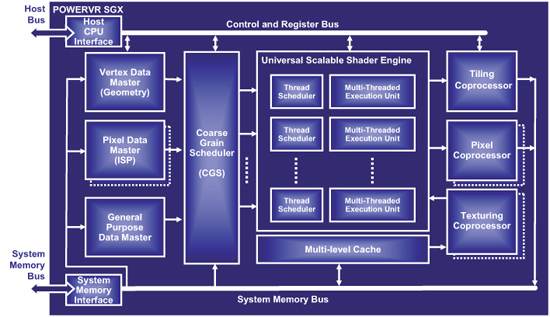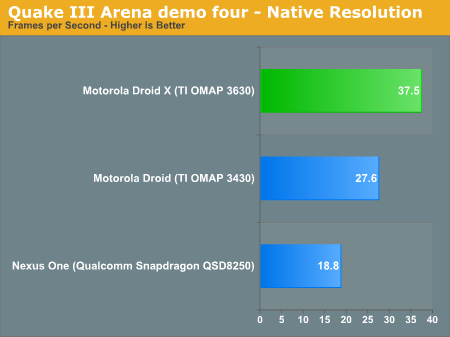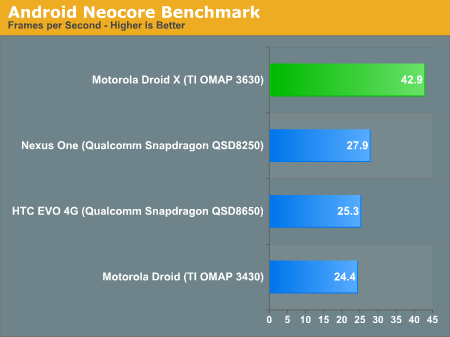Motorola Droid X: Thoroughly Reviewed
by Brian Klug on July 20, 2010 4:27 PM EST- Posted in
- Smartphones
- Motorola Droid X
- OMAP
- Mobile
The OMAP GPU - Powered by Imagination Technologies
TI continues to license its GPUs from Imagination Technologies. Rather than move to the PowerVR SGX 535 used by Apple and Intel, TI stuck with the same PowerVR SGX 530 core used in the OMAP 3430. The difference between the SGX 530 and 535 is as follows.
ImgTec refers to the execution hardware in its Series 5 GPUs as a Universal Scalable Shader Engine (USSE). Each USSE pipe can execute a 2-wide vector or up to a 4-way SIMD scalar op in a single clock. Both the SGX 530 and 535 have two USSE pipes from what I can tell.

The SGX 535 used in Apple’s A4 and Intel’s Atom Z600 series apparently have a second texturing unit and DirectX 9L support.
We’d expect that 3D apps on smartphones are more compute bound these days so it’s difficult to say how much you lose by going with the SGX 530 vs. 535. Until we get a Moorestown dev kit running Android we won’t be able to shed much light on that.
While the OMAP 3430 ran the GPU core at ~110MHz, the 3630 ramps it up to 200MHz. We’re seeing a lot of convergence around this 200MHz mark at 45nm. Intel runs the SGX 535 in Moorestown (Atom Z600 series) at 200MHz as well and I believe that’s what Apple uses in the A4 as well.
The 80% increase in GPU clock speed should result in significant real world GPU performance improvements. Just as with the CPU, there are no significant architectural changes to the GPU - it just runs faster.
The memory controller is still a 32-bit LPDDR1 interface, but can now run at up to 200MHz (the 3430 was limited to 166MHz). Should a customer choose to go for 200MHz LPDDR1 you’d get a 20% increase in memory bandwidth which will come in handy with the faster GPU in 3D apps for sure.
The GPU Performance Showdown: Snapdragon vs. OMAP 3630
When Brian first started cranking on the Droid X review he wanted to put the Qualcomm Adreno 200 vs. PowerVR SGX debate to rest. We had always reported that Qualcomm’s Snapdragon GPU was slower than the PowerVR SGX used in Apple’s A4 and TI’s OMAP 3, but we didn’t have a good idea of how much slower. Until now that is.
Armed with the Google Nexus One (Snapdragon QSD8250), Motorola Droid (OMAP 3430) and Motorola Droid X (OMAP 3630) all running Android 2.x (the N1 was running 2.2) we polished off one of the most popular GPU benchmarks of our time: Quake III Arena.
The kwaak3 project ported Q3A from a Nokia N900 version to Android. With a bit of elbow grease and getting around the lack of touchscreen keyboard support, we got the benchmark running. All scores were generated at default graphics quality settings and at native resolution, which unfortunately means the Droid X has around 7% more pixels to render than the other Android devices.

Even with the handicap, the 200MHz PowerVR SGX 530 core manages double the frame rate of the Adreno 200 in the Nexus One’s Snapdragon. Even the 110MHz SGX 530 is faster.
Here’s another interesting tidbit - we’re actually CPU bound on all of these platforms running demo four in Q3A:

Droid X (OMAP 3630) CPU utilization while running Quake III Arena
Intel is talking about greater than 100 fps frame rates with Atom Z600, meaning that the advantage is strictly on the CPU side. This also tells us that the PowerVR SGX 530 may even be a good fit for next year’s Cortex A9 based SoCs, even though TI has already committed to using the SGX 540 in its OMAP 4 line.
Neocore is another popular GPU benchmark, although this one is written for Qualcomm’s Adreno 200. The OpenGL ES 1.1 benchmark is mostly a GPU test but also stresses the platform as a whole. Running on our OMAP 3 based phones we see an average of 50% CPU utilization during the test.

The Droid X (OMAP 3630) CPU utilization while running Neocore
Interestingly enough, running the same test on a Snapdragon platform shows higher CPU utilization:

The Nexus One (Snapdragon) CPU utilization while running Neocore
The benchmark could be very well optimized for Qualcomm’s Scorpion core resulting in better CPU utilization compared to a Cortex A8.

The Adreno 200 in the Nexus One and EVO 4G outperforms the PowerVR SGX in the original Droid by 4 - 14%. This isn’t a surprise given the Qualcomm branding on the benchmark. The 45nm SGX 530 running at 200MHz puts all question to rest, the OMAP 3630 is 53% faster than Snapdragon.
The comparison here is obviously more than just GPU to GPU. We’re dealing with different CPU cores (ARM Cortex A8 vs. Qualcomm Scorpion), different memory controllers, different caches, and different drivers. Just as we’ve seen in the desktop GPU race, driver and benchmark optimizations have a lot to do with 3D performance results. I put more faith in the Quake 3 results, however those too came from a port optimized for PowerVR’s SGX.










89 Comments
View All Comments
numberoneoppa - Wednesday, July 21, 2010 - link
Can't wait, I look forward on your impressions on Samsung's touchwizz overlay, from what I can tell, it rather hurts the GUI performance. :(Zebo - Wednesday, July 21, 2010 - link
Would be nice if these smart phones reviews had a large table for quick access to pro's and con's of each phone.Each box/catagory in the table could be based on 1-10 with a little narrative or to as simple as just check mark for superiority.
Hey it's a perfect review so i had to make something up to nag about:)
Droid X seems to be top dog android...- Evo is unsuitable you actually USE the phone's unlimited plan with it's poor batt life but just as nice too. Hard to pick.
radium69 - Wednesday, July 21, 2010 - link
Thank you Brian & Anand, for this in depth review.I find your articles to be very interesting, and well written!
Keep up the good work!
mvmorr01 - Wednesday, July 21, 2010 - link
Thanks, cool app!LoneWolf15 - Wednesday, July 21, 2010 - link
(quote)"The Droid X is the spiritual successor to last year’s Droid."(/quote)Actually, I'd say the upcoming Droid II is the sequel, as it has a fully tactile keyboard, as opposed to the touchscreen Droid X. I'd say the Droid X is a new product rather than a successor.
I'm waiting to see what the Droid II can do --I won't buy a smartphone that doesn't have a physical keyboard.
tbuck79 - Wednesday, July 21, 2010 - link
I have a Droid X, the WiFi is terrible on my Netgear Router but at work on a Linksys router it's fine (both are single band N), however, using any WiFi the distance is really bad with the X, compared to an iPhone 4 in my other hand, the iPhone can get MUCH farther away from the AP than the X, could you guys see if there is an actual problem with range on the X?WaltFrench - Saturday, July 24, 2010 - link
you must be holding the X the wrong way.Ratman6161 - Wednesday, July 21, 2010 - link
The Droid and the Doid X are both Android 2.1 and both are soon to be upgraded to 2.2 (mine already is). The run the same apps and do the same things (weather or not you like Motoblur and find it an advantage is up to you). The Droid will basically do everything the Droid X does - just not quite as fast. So "obsolete" is a matter of perspective. That's what Verizon and Motorola would like us to think. They just love people like your friend who ditched his Droid for an Incredible and now wants to ditch the incredible for a Droid X.Lets face it - it's evolution not revolution. If you are always trying to have the latest cool gadget, you are always going to end up disappointed and with a much thinner wallet.
Good review though. If I were buying today I'd probably go with the X. But with another year to go before the next upgrade, something else will come along long before I'm ready to buy.
digipro55 - Wednesday, July 21, 2010 - link
Incredibly well written and through review. I can admit I didn't understand all the jargon in the performance tests but it certainly is a wealth of knowledge concerning the best Android phone on the market. Thanks again for a very informative reviewAikouka - Wednesday, July 21, 2010 - link
Hey Brian, just to let you know, the mini-HDMI to HDMI cables are available at Monoprice, but of course it sounds like you were looking for one ASAP from a B&M store :). So I guess if you know you'll need one, you can order one, but it also looks like they're not terribly commonplace as you mentioned as they're kind of expensive on Monoprice compared to standard HDMI cables.